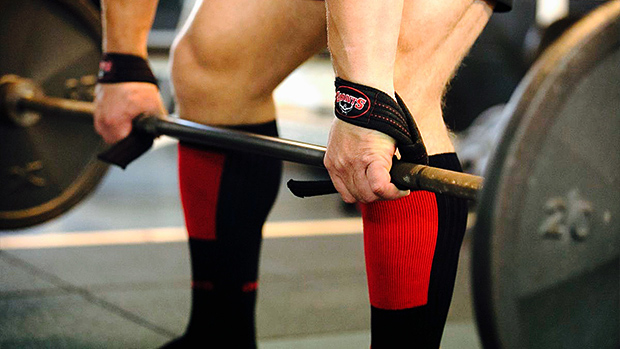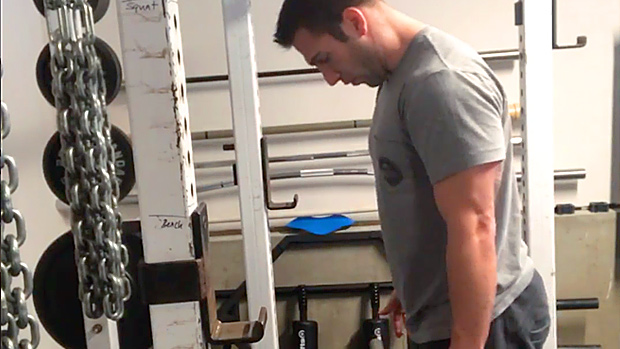Q: I'm not having any luck training my triceps. I'm sure it's because I've been doing the same old routine forever. Got a good tricep routine that I can try out today?
A: There are two important variables that will lead to large increases in triceps mass:
- Choosing the right exercises
- Using a variety of rep brackets
With those two points in mind, here's a great triceps mass building routine:
- A. Parallel Dips
- Sets: 5
- Reps: 4-6
- Tempo: 5110*
- Rest: 180 seconds between sets
* For those newcomers among you who are still unfamiliar with the concept of tempo, the designation 5110 means to take 5 seconds to do the eccentric, or lowering, part of the movement; followed by a one-second pause; followed by a one-second lifting, or concentric, movement; and no pause before doing the next rep.
In my opinion, this is the king of triceps builders. Yet, like the ever demanding squats and chins, it rarely makes the Men's Fitness pulley artist-type of routines.
To start the exercise, hold the bars and boost yourself up until you've stabilized yourself at arm's length over the handles. Then, lower your body as far as possible in between the bars. In fact, lower your body until your biceps make contact with your forearms–your triceps must get fully stretched. Once you reach the bottom position, press yourself back up by extending the elbows. Try to stay as upright as possible throughout the range of motion. If you lean too far forward, it will increase the recruitment of the pectoralis muscle.
If you can't lower yourself under control until the biceps make contact with the forearms, go back to collecting stamps, or perform decline close-grip bench presses until your arm strength is sufficient. Using an incomplete range in the triceps dips is a complete waste of time. And please do not go for the El Geeko version where you put your feet on a bench in front of you and your hands behind you. This exercise, along with Smith machine pressing exercises, is one of the major causes of shoulder impingement syndromes in the bodybuilding community.
At first, your bodyweight will probably provide enough resistance. As you get stronger, you can progressively increase the resistance by holding a dumbbell between your legs or hooking a plate or dumbbell to the specialized chin/dip belt. There are a lot of chin/dip belts on the market, but I prefer the ones that are standard leather lifting belts with hooks sewed into the belt.
If you have access to the better V-shaped dipping bar, use as narrow a grip as possible without, of course, compromising shoulder integrity. And please, do not cheat yourself by doing chopped reps where you don't go all the way down and you only come up three quarters of the way. By the same token, your elbows should only come to 98% of lockout to maintain maximal tension on the triceps.
- B1. Incline Dumbbell Extensions
- Sets: 3
- Reps: 6-8
- Tempo: 3210
- Rest: 0 seconds (superset with B2)
Lie on an incline bench and hold two dumbbells at arm's length. Lower the dumbbells while keeping the elbows themselves stationary. Make sure that the triceps are fully stretched in the bottom position (the forearms should be in contact with the biceps at that point in the range of motion). Use a semi-supinated grip.
Don't get too anal about wanting the tips of the elbows as close as possible as it creates a lot of strain on the supportive structures of the elbow.
- B2. Lying Cable Triceps Extensions
- Sets: 3
- Reps: 2-15
- Tempo: 2010
- Rest: 120 seconds between supersets
Use a revolving-type handle attached to a low pulley. Place a flat bench perpendicular to the cable station. Lie on the bench with your head close to the machine. Grasp the bar and extend it overhead. Bring the bar to the forehead on the eccentric descent and extend the elbows until they are at 98% of lockout. Be sure to keep your wrists in a neutral position to prevent any future elbow problems.
I've seen many individuals gain as much as a half-inch on their triceps in 30 days using this workout every five days or so.
Q: I see women doing lunges all the time, but I rarely see men doing them. What's your take on lunges? Are they strictly to develop the ass, or do they work the quads and hamstrings too?
A: You rarely see men do these exercises because of the standard bodybuilding bullshit that lunges are designed to "tone your butt." This falls into the same category of bullshit as the belief that leg extensions will cut up your legs.
Nothing can be further from the truth, though. I have seen many sprinters, jumpers, and bobsledders add inches to their already muscular legs by supplementing their squatting programs with lunges or split squats. By the way, the difference between a split squat and a lunge is that during the concentric portion of a lunge, you explode back to an upright position. With the split squat, you use a stationary stance where you go up and down on the forward leg.
Here is how to perform split squats properly:
Starting Position Setup
- Stand facing away from a barbell placed on a squat rack.
- Using your index fingers, set up a reference point on the bar (use the knurling to determine the width of the grip).
- The index fingers should be as close as possible to the outside of the shoulders.
- Duck under the bar and place the bar on the thick area of the trapezius muscle.
- The chin should be be slightly up.
- Focus your eyes at a point on the opposing wall that's slightly higher than the eye in order to maintain proper neck alignment.
- Feet should be shoulder-width apart.
- Take a big step directly forward with your non-dominant leg to reach the initial starting position.
Descent
- The front knee moves directly forward maximally before the hips are lowered.
- The hips are then lowered keeping the back as erect as possible and the chest up.
- The body is lowered under control until the hamstrings come in contact with the calves.
- There should be a conscious effort to keep the elbows under the bar throughout the movement. This will ensure that the load is kept as close as possible over the center of gravity.
- The knee should be traveling forward and over your toes throughout the descent.
- The athlete should inhale through the mouth throughout the descent.
Ascent
- The athlete should first raise the hips.
- The torso should remain as perpendicular to the floor as possible, particularly at the sticking point.
- The athlete should exhale throughout the ascent.
Watch Fors
- Trunk should be as erect as possible throughout the movement.
Safety Concerns
- Keep the eccentric lowering under control.
- Do not lean forward.
Variations
- To change the resistance curve on this movement, you can hold dumbbells; position the barbell on the traps; keep the barbell on the clavicles using a front squat grip; or hold a single handle hooked to a low pulley using the contralateral hand (opposite).
- Not only do these exercises develop the glutes, they also provide plenty of growth stimulus for the quadriceps, adductors, and hamstrings. They also provide plenty of leg growth stimulus on days where you may want to overload the spine by squatting or deadlifting.
Q: Wide-grip pull-ups are one of my favorite back exercises, but I've sort of stalled on them. I know you say trainees should be able to do at least 12 reps using bodyweight, but I haven't been able to get beyond eight. Any suggestions?
A: Here are three tips that will help you break through your wide-grip pull-up plateau:
- On the last rep of every set, pause on the way down (eccentrically) at three different positions for eight seconds each time. In other words, pause for eight seconds when you're one-fourth of the way down, halfway down, and three-fourths of the way down. This will prolong the time under tension of the exercise, thus favoring protein synthesis. Don't be surprised if on your last isometric stop you look like you have an extreme case of Parkinson's Disease.
- On the last rep of every set, have a partner put a dumbbell between your ankles to augment the eccentric overload and try to lower yourself (and the dumbbell) over a span of ten seconds.
- Supplement your arm training day with direct brachialis work. Make sure to always perform one form of reverse curls on arm days and, while doing them, pause for a count of two seconds when your elbows reach 30 degrees of flexion on every eccentric lowering (this will increase the recruitment of the brachialis muscle).
Q: I have read some of your articles where you talk about "time under tension" and recommend sometimes doing sets where you take one or two seconds to raise the weight while taking anywhere from three to eight seconds to lower it. Is there any point in doing extreme time-under-tension reps? For example, I tried doing some sets of dips where it took me 15 seconds to raise my body and another 15 seconds to lower it. It hurt like hell. Did I discover something interesting, or am I just doing a slow-motion jerk-off?
A: Don't rush to the patent office just yet. On the other hand, don't put yourself down. My colleague Ellington Darden suggested many moons ago to do chins or dips using a 30-second count for both the concentric and the eccentric portions of those lifts.
Likewise, former Soviet weightlifting coach Medvedev recommended very slow (8-10 seconds) pulls (more like deadlifts) for developing maximal strength in weightlifters.
You can use extreme time-under-tension training as long as the total time under tension does not exceed 60 seconds–otherwise, the load would be too low to elicit strength and muscle mass gains.




